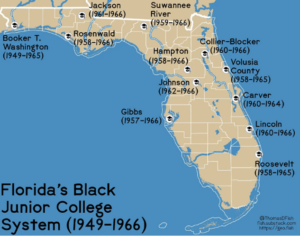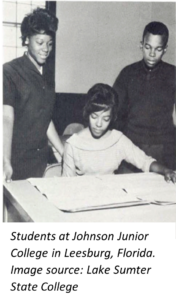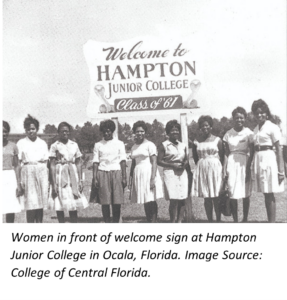Authored By: Dr. Carrie Henderson
The great 28.
That term refers to the state of Florida’s 28 state and community colleges. State officials, college leaders, administrators, and students all acknowledge the significance of this network of higher education, and for good reason. Florida consistently tops the charts in higher education rankings by U.S. News and World Report. Moreover, in the realm of prestigious accolades, such as the Aspen Prize for Community College Excellence, the Florida College System stands out as a dominant force. 
The Florida College System and its member colleges have evolved significantly, progressing from junior colleges to community colleges, and now to state colleges, in response to the continually changing needs of our state. Yet, amidst the narrative of this evolution, one crucial aspect often goes overlooked: the history of Florida’s 12 Black junior colleges.
In 1949, the Florida Legislature laid the foundation for the first Black junior college, Booker T. Washington Junior College. Subsequently, the Magnificent 12, comprising 11 more colleges, emerged post-1954, following the landmark Brown v. Board of Education ruling.
A recalcitrant Florida Legislature established a system of Black junior colleges, which in practice lacked the facilities, financial support, and administration equal to those of their white counterparts. Despite these obstacles, from 1949 to 1966, these 12 institutions served Black students, offering their sole avenue to a college degree within an inclusive environment.
By 1967, however, no Black junior colleges remained, marking the end of the Magnificent 12. 
Unlike Alabama or South Carolina, where a few Historically Black Colleges and Universities were retained within the public two-year education system, Florida pursued a different approach. Rather than maintaining separate institutions, Florida’s Black junior colleges were “merged” with nearby newly established white junior colleges, ostensibly as a move towards desegregation.
However, in practice, only one Black junior college, Lincoln Junior College, underwent a full merger with its white counterpart, becoming part of Indian River State College. As detailed in Dr. Walter L. Smith’s influential work, “The Magnificent 12: Florida’s Black Junior Colleges,” the remaining 11 Black junior colleges were “folded in” to the white institutions. Faculty members from these institutions faced limited opportunities to continue teaching at their new establishments.
Scholars have extensively documented the collective experiences of Black students who were among the first to integrated in the public education system. These experiences encompass feelings of rejection, alienation, a sense of displacement, grief, and intense pressure, as evidenced by the works of Poff (2016), Gbemi (2016), Taylor (1989), Feagin and Sikes (1995), and Williamson (1999).
As a white woman, I recognize that these are experiences I cannot fully comprehend. Still, I am committed to trying to do so, remembering the wisdom imparted by Atticus to Scout: “You never really understand a person until you consider things from his point of view. Until you climb inside of his skin and walk around in it.” 
Reflecting on the present environment, faculty members within Florida College System institutions may face challenges in teaching frameworks that help us understand the role of the state in the creation and dissolution of Black junior colleges. They may hesitate to include lessons in their courses derived from the lived experiences of Black students during periods of segregation, desegregation, and integration. The extent to which these topics are permitted or explored in classrooms remains uncertain.
What remains unequivocal, however, is that the history of the Florida College System is inherently incomplete without the inclusion of the Black junior college system.
The next time you hear reference to “the great 28,” I urge you to also recollect the significance of the Magnificent 12.